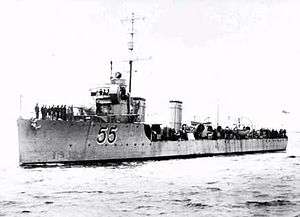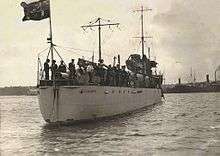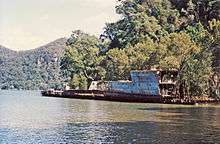HMAS Parramatta (D55)
 HMAS Parramatta in 1918 | |
| History | |
|---|---|
| Namesake: | Parramatta River |
| Builder: | Fairfield Shipbuilding and Engineering Company Limited |
| Laid down: | 17 March 1909 |
| Launched: | 9 February 1910 |
| Commissioned: | 10 September 1910 |
| Decommissioned: | 20 April 1928 |
| Honours and awards: |
|
| Fate: | Sold for scrap, some components later converted into memorials |
| General characteristics | |
| Class and type: | River-class torpedo-boat destroyer |
| Displacement: | 750 tons |
| Length: | 246 ft (75 m) overall |
| Beam: | 24 ft 3.75 in (7.4105 m) |
| Draught: | 8 ft 6 in (2.59 m) |
| Propulsion: | 3 × Yarrow boilers, Parsons turbines, 10,000 hp (7,500 kW), 3 shafts |
| Speed: | 26 knots (48 km/h; 30 mph) |
| Range: | 2,690 nautical miles (4,980 km; 3,100 mi) at 11.5 knots (21.3 km/h; 13.2 mph) |
| Complement: | 66–73 |
| Armament: |
|
HMAS Parramatta, named after the Parramatta River, was a River-class torpedo-boat destroyer of the Royal Australian Navy (RAN). Ordered in 1909 for the Commonwealth Naval Forces (the predecessor of the RAN), Parramatta was the first ship launched for the Australian navy. Temporarily commissioned into the Royal Navy for the delivery voyage to Australia, the destroyer came under Australian naval control in 1910, and on 1 March 1911 was recommissioned into the RAN, shortly before the latter's creation.
From 1914 to 1917, Parramatta was involved in wartime patrols in the Pacific and South East Asian regions, before she and her sister ships were transferred to the Mediterranean for anti-submarine operations. She returned to Australia in 1919, and was placed in reserve. Apart from a brief period of full commission during the visit of the Prince of Wales, Parramatta remained in reserve commission until 1928. She was fully decommissioned in 1928, stripped of parts, and sold for use as prisoner accommodation on the Hawkesbury River. After changing hands several times, the hull ran aground during gale conditions in 1933, and was left to rust. In 1973, the bow and stern sections were salvaged, and converted into memorials.
Design and construction
Parramatta had a displacement of 750 tons, a length overall of 246 feet (75 m), and a beam of 24 feet 3.75 inches (7.4105 m).[1] The destroyer was powered by three Yarrow oil-burning boilers connected to Parsons turbines, which delivered 10,000 shaft horsepower to three propeller shafts.[2] Parramatta's cruising speed was 11.5 knots (21.3 km/h; 13.2 mph), giving the ship a range of 2,690 nautical miles (4,980 km; 3,100 mi).[3] Her maximum speed as designed was 26 knots (48 km/h; 30 mph), but during sea trials, she was able to achieve 27.3 knots (50.6 km/h; 31.4 mph).[1] The ship's company consisted of between 66 and 73 personnel, including five officers.[2]
.jpg)
Parramatta, along with sister ships Yarra and Warrego, were ordered on 6 February 1909; the first ships to be ordered for the Commonwealth Naval Forces, the post-Federation amalgamation of the Australian colonial navies.[4] The ship was laid down by Fairfield Shipbuilding and Engineering Company Limited, at their shipyard in Govan, Scotland on 17 March 1909.[1] She was launched on 9 February 1910 by Margot Asquith, wife of British Prime Minister H. H. Asquith; the first new ship launched for the Australian navy.[2][5] Construction was completed in August 1910, and the ship was commissioned into the Royal Navy as HMS Parramatta for the voyage out to Australia.[2] Parramatta and sister ship Yarra sailed from Portsmouth on 19 September.[2] Once the ships arrived in Broome, they were transferred to the control of the Commonwealth Naval Forces.[2]
Operational history
Early career
After entering Australian control, the two ships sailed to Melbourne for a gala welcome.[2] During the celebrations, the ship's engineering officer fell overboard and drowned.[2] On 1 March 1911, Parramatta was recommissioned as His Majesty's Australian Ship, although the HMAS prefix was not officially approved until 10 July, when King George V granted permission for the Commonwealth Naval Forces to be renamed the Royal Australian Navy.[2]
On 4 October 1913, Parramatta took part in a formal fleet entry into Sydney Harbour welcoming the battlecruiser HMAS Australia.[6]
World War I
During the early stages of World War I, Parramatta operated with the Australian fleet in the search for the German East Asia Squadron, then was involved in the capture of German colonies in the South Pacific region, including German New Guinea, and the consolidation of Allied occupation in these regions.[2] On 5 February 1915, Parramatta and sister ships Yarra and HMAS Warrego sailed for Australia, where they were used for convoy escort duties along the continent's eastern coast until November.[2] The ships were refitted at Sydney, then sent to patrol the region around Malaya, the East Indies, and the Philippines.[2] Parramatta returned to Australia on 17 July 1916, and patrolled home waters until 17 May 1917, when she and her sister ships were ordered to Malta.[2]

On arrival, the six River-class ships were to undergo anti-submarine training, but were instead immediately deployed on convoy escort operations from Port Said to Malta.[2] On 16 August, lookouts aboard Parramatta spotted the wake from a periscope.[2] The destroyer sped to the area of the sighting, and dropped a depth charge on a submarine travelling just below the surface.[2] After completing the convoy run, the Australian warships completed the training, and were assigned to patrols of the Adriatic.[2] For this, Parramatta was fitted with an observation balloon.[7] On 16 November 1917, Parramatta and several sister ships came to assist the Italian transport Orione, whose stern had been destroyed by a torpedo.[8] Parramatta towed the stricken ship towards the mainland, while Warrego and Swan recovered survivors and Yarra chased the attacking submarine.[7] Apart from this, the patrols were uneventful, and on 28 September 1918, Parramatta underwent refit in Greece before joining Allied forces at Constantinople.[7] During October 1918, following the surrender of Turkish forces, Parramatta accepted the surrender of a German admiral assigned to the area.[7] The destroyer was then used for mail runs between Constantinople and Sabastapol until December, when she sailed to Devonport, arriving on 14 January 1919.[7]
During her career, Parramatta received no honours or awards for her activities during World War I.[9] Following an overhaul of the RAN battle honours system, completed in March 2010, the ship's wartime service was retroactively recognised with the honours "Rabaul 1914" and "Adriatic 1917–18".[10][11]
Post-war
On 6 March 1919, Parramatta sailed for home, in company with several other Australian ships.[7] Parramatta and Yarra ran out of fuel on 26 April, less than a day out from Darwin, and had to be towed into port by Warrego.[7] The destroyer paid off into reserve at Sydney on 22 July 1919.[7] She was recommissioned for the period 17 May to 13 June 1920 for the visit of the Prince of Wales in HMS Renown, then was returned to reserve.[7] From October 1924 until November 1925, Parramatta was based at Westernport, Victoria for use as a training ship, then spent time in Sydney, then Adelaide, before returning to Sydney in April 1928.[7]
Decommissioning and fate

Parramatta was paid off from service on 20 April 1928 and handed over to the Cockatoo Island Dockyard for dismantling on 17 October.[7] Parramatta and Swan were stripped down, and their hulks were sold to NSW Penal Department and towed to Cowan Creek, where they were used to house prisoner labourers working on roads along the Hawkesbury River.[7] The two hulks were then sold in 1933 for 12 pounds each to George Rhodes of Cowan, New South Wales, who intended to use them as accommodation for fishers.[7] This was opposed, and the ships were sold on to a pair of fishermen, who used them to transport blue metal to Milson and Peat Islands.[7]
On 2 February 1934, Parramatta and Swan were being towed down the Hawkesbury River for final breaking in Sydney, when gale conditions caused both hulls to break their tows; Swan foundered and sank, while Parramatta ran aground in mangroves opposite Milson Island and was abandoned in position 33°30.07′S 151°10.88′E / 33.50117°S 151.18133°ECoordinates: 33°30.07′S 151°10.88′E / 33.50117°S 151.18133°E.[7] In 1973, the bow and stern sections of Parramatta were salvaged, with the stern established as a memorial on the south bank of the Parramatta River in Parramatta, New South Wales, and the bow later placed outside the Royal Australian Navy Heritage Centre, at the northern tip of the naval base at Garden Island, New South Wales.[12]
Citations
- 1 2 3 Cassells, The Destroyers, p. 74
- 1 2 3 4 5 6 7 8 9 10 11 12 13 14 15 16 17 Cassells, The Destroyers, p. 75
- ↑ Cassells, The Destroyers, p. 74-5
- ↑ Stevens, in Stevens, The Royal Australian Navy, p. 18
- ↑ Stevens, in Stevens, The Royal Australian Navy, p. 19
- ↑ Stevens, in Stevens, The Royal Australian Navy, pp. 25–6
- 1 2 3 4 5 6 7 8 9 10 11 12 13 14 15 Cassells, The Destroyers, p. 76
- ↑ Cassells, The Destroyers, pp. 75–6
- ↑ Cassells, The Destroyers, p. 77
- ↑ "Navy Marks 109th Birthday With Historic Changes To Battle Honours". Royal Australian Navy. 1 March 2010. Archived from the original on 13 June 2011. Retrieved 23 December 2012.
- ↑ "Royal Australian Navy Ship/Unit Battle Honours" (PDF). Royal Australian Navy. 1 March 2010. Archived from the original (PDF) on 14 June 2011. Retrieved 23 December 2012.
- ↑ Cassells, The Destroyers, pp. 76–7
References
- Cassells, Vic (2000). The Destroyers: their battles and their badges. East Roseville, NSW: Simon & Schuster. ISBN 0-7318-0893-2. OCLC 46829686.
- Stevens, David (2001). Stevens, David, ed. The Royal Australian Navy. The Australian Centenary History of Defence (vol III). South Melbourne, VIC: Oxford University Press. ISBN 0-19-555542-2. OCLC 50418095.
External links
| Wikimedia Commons has media related to HMAS Parramatta (D55). |